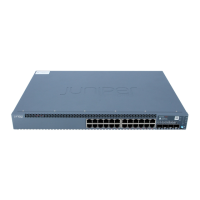Configuring SNMP (J-Web Procedure)
NOTE: This topic applies only to the J-Web Application package.
You can use the J-Web interface to define system identification information, create SNMP
communities, create SNMP trap groups, and configure health monitor options for EX
Series switches.
To configure SNMP features:
1. Select Configure > Services > SNMP.
2. Enter information into the configuration page for SNMP as described in
Table 67 on page 131.
3. To apply the configuration click Apply.
NOTE: After you make changes to the configuration on this page, you
must commit the changes for them to take effect. To commit all changes
to the active configuration, select Commit Options > Commit. See Using
the Commit Options to Commit Configuration Changes for details about
all commit options.
Table 67: SNMP Configuration Page
Your ActionFunctionField
Identification
Type contact information for the administrator of
the system (such as name and phone number).
Free-form text string that specifies an administrative
contact for the system.
Contact
Information
Type information that describes the systemFree-form text string that specifies a description for the
system.
System
Description
Type the MAC address of Ethernet management
port 0.
Provides an administratively unique identifier of an
SNMPv3 engine for system identification.
The local engine ID contains a prefix and a suffix. The
prefix is formatted according to specifications defined
in RFC 3411. The suffix is defined by the local engine ID.
Generally, the local engine ID suffix is the MAC address
of Ethernet management port 0.
Local Engine ID
Type location information for the system (lab
name or rack name, for example).
Free-form text string that specifies the location of the
system.
System Location
131Copyright © 2017, Juniper Networks, Inc.
Chapter 10: Configuring Services

